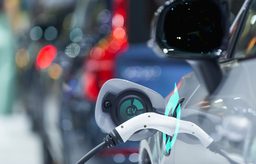Vehicle-to-Vehicle Power Transfer
TECHNOLOGY NUMBER: 2018-359

OVERVIEW
Vehicle-to-vehicle tethered power transfer for frequent, real-time, on-demand charging- May be used as a crowd-sourced power storage and supply system
- Allows for decreased battery size and increased EV trip range
BACKGROUND
While electrical vehicles have made strides in the automotive market, they are still limited by imperfect charging station infrastructure and the heavy weight of car batteries. Limited driving range as well as the existence of geographic areas with sparsely situated charging stations contribute to driver anxiety and deter potential EV buyers. One further barrier to a more widespread adoption of EVs includes an initial higher purchase price which results partly from the expense associated with batteries. The costs of replacing worn out EV batteries must be taken into account when calculating the long term expense of vehicle purchase. Also, from a convenience standpoint, recharging EVs during a long trip requires a larger time investment than does refilling the gas tank for a traditionally powered or even hybrid vehicle. So, a need exists for methods to decrease initial EV cost, to improve options to charge them, and to improve market penetration by allaying the concerns of potential buyers.
INNOVATION
Researchers have created a vehicle-to-vehicle (V2V) tethered power transfer (TPT) between electronic vehicles (EVs) to facilitate frequent, real-time, and on-demand charging. V2V TPT mimics aerial refueling of fighter planes, which permits those jets to function with smaller fuel tanks while remaining lighter, fuel efficient, and more nimble. In V2V TPT, EVs equipped with retractable charging apparatus (e.g., tethers or booms) deploy automatically between a charging and receiving vehicle while they are in motion. V2V TPT may be utilized through a sharing paradigm where EVs and other specialized charging vehicles form a mobile network of crowd-sourced power storage and supply. A well-designed V2V TPT system will allow for a drastic reduction in battery size which can correspondingly decrease vehicle cost. Initial analysis suggests the possibility for 50% reduction in EV battery size which reduces energy consumption as a result of smaller vehicle weight. This innovation may therefore increase the penetration rate of EVs due to a lower vehicle purchase cost as well as increased range that results from a lighter weight.
PATENT APPLICATION
Number:17/056,322
https://patentcenter.uspto.gov/applications/17056322
Status: Filed